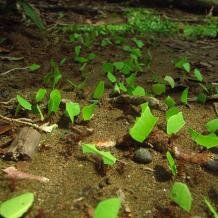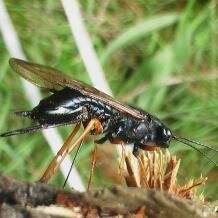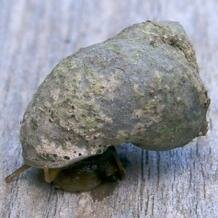Topic: Agriculture: from ants to dugongs
Human farmers tending their fields are a familiar sight. But don't forget about those fungus-farming termites or the fish with a garden of algae…
 Not only has agriculture evolved at least four times in humans, but it has also emerged in several other animals. These systems reveal many striking convergences…
Not only has agriculture evolved at least four times in humans, but it has also emerged in several other animals. These systems reveal many striking convergences…
Terrestrial agriculture
In the terrestrial realm, agriculture has arisen independently in diverse groups of insects, in all cases based on the cultivation of fungi.
Ants, termites and ambrosia beetles
 Ant agriculture, which is best known from the attines but has also evolved in some other groups, shows many striking similarities to that of humans. Leafcutter ants cultivate a monoculture of a particular fungus on freshly cut pieces of leaf, fertilising it with their nitrogen-rich excretions. To prevent the invasion of parasitic fungi, the workers apply fungicides, antibiotics secreted by symbiotic bacteria that live on the ants’ bodies, regularly weed the crop and remove waste. The sugar-rich tips (gongylidia) of the hyphae are harvested and used to nourish the brood. Just as in human agriculture, fungal cultivars are exchanged horizontally between both colonies and species.
Ant agriculture, which is best known from the attines but has also evolved in some other groups, shows many striking similarities to that of humans. Leafcutter ants cultivate a monoculture of a particular fungus on freshly cut pieces of leaf, fertilising it with their nitrogen-rich excretions. To prevent the invasion of parasitic fungi, the workers apply fungicides, antibiotics secreted by symbiotic bacteria that live on the ants’ bodies, regularly weed the crop and remove waste. The sugar-rich tips (gongylidia) of the hyphae are harvested and used to nourish the brood. Just as in human agriculture, fungal cultivars are exchanged horizontally between both colonies and species.
An equally sophisticated (but less well-known) fungal agriculture has developed independently in termites. They tend gardens of fungi that grow on the so-called combs, organic-rich structures built of faecal pellets, in special chambers. The fungus is mainly acquired by horizontal transmission, but vertical transmission from one generation to the next has also been documented. As in leafcutter ants, termite gardens are monocultures that are protected from microbial infection and carefully kept clean. The fungi also produce special nutrient-rich structures that can easily be harvested, but their exact nutritional role remains unknown.
 In beetles, fungus farming has independently evolved several times, most famously in the ambrosia beetles, a diverse group of derived weevils. They carve out intricate galleries in the xylem of trees, where they farm ascomycete fungi. Although beetle gardens are typically dominated by one primary fungus, they are usually not pure monocultures. Similar to ants and termites, the beetles weed their gardens and control pathogens. They depend on the fungi for essential vitamins, amino acids and sterols, but the ambrosia fungi do not seem to produce special nutrient-rich structures. Sympatric beetles might share fungal cultivars, and cultivars are also transmitted vertically. When female reproductives disperse, they carry inocula from their natal fungus garden in specialised pockets, the so-called mycangia.
In beetles, fungus farming has independently evolved several times, most famously in the ambrosia beetles, a diverse group of derived weevils. They carve out intricate galleries in the xylem of trees, where they farm ascomycete fungi. Although beetle gardens are typically dominated by one primary fungus, they are usually not pure monocultures. Similar to ants and termites, the beetles weed their gardens and control pathogens. They depend on the fungi for essential vitamins, amino acids and sterols, but the ambrosia fungi do not seem to produce special nutrient-rich structures. Sympatric beetles might share fungal cultivars, and cultivars are also transmitted vertically. When female reproductives disperse, they carry inocula from their natal fungus garden in specialised pockets, the so-called mycangia.
Ants, termites and ambrosia beetles all show some degree of sociality, which is likely to have facilitated the evolution of agriculture – there is an inherent advantage of a division of labour. While ants and termites are eusocial, only one species of ambrosia beetle has evolved eusociality (the others are subsocial or communal). Ambrosia beetle colonies remain small, but those of ants and termites can grow to a huge size and have a major ecological impact. From the human perspective, they are often serious pests, whereas ambrosia beetles, which typically target dead trees, seldom do any economic damage.
Wood wasps and gall midges
 Some other insects also form an intimate association with symbiotic fungi, showing a number of striking convergences with the ambrosia beetles. The larvae of wood wasps bore into wood, where they form galleries that are colonised by fungi (often causing serious economic damage in the process), while the larvae of some gall midges produce so-called ‘ambrosia galls’ that contain the mycelium of a symbiotic fungus. In both groups, the fungus is collected by the female, transported in mycangia and introduced into the plant upon oviposition. The fungus, which relies on the insect for dispersal, is crucial for larval development. Wood wasp larvae require ingested fungal enzymes to break down cellulose, and gall midge larvae consume a complex consisting of protein-rich fungal hyphae and plant cells.
Some other insects also form an intimate association with symbiotic fungi, showing a number of striking convergences with the ambrosia beetles. The larvae of wood wasps bore into wood, where they form galleries that are colonised by fungi (often causing serious economic damage in the process), while the larvae of some gall midges produce so-called ‘ambrosia galls’ that contain the mycelium of a symbiotic fungus. In both groups, the fungus is collected by the female, transported in mycangia and introduced into the plant upon oviposition. The fungus, which relies on the insect for dispersal, is crucial for larval development. Wood wasp larvae require ingested fungal enzymes to break down cellulose, and gall midge larvae consume a complex consisting of protein-rich fungal hyphae and plant cells.
Marine agriculture
Rather more extraordinarily, agriculture has also emerged in a marine setting, usually in the form of algal cultivation. However, in one case, it is seagrass that is “farmed” and in another, more remarkable example once again it is a fungus!
Fungal farming
 The marsh periwinkle (Littoraria irrorata) is the only marine fungus farmer known to date. It wounds a marsh grass with its radula, which leads to the plant tissue being invaded by an ascomycete fungus that the snail then feeds on. Fungal growth is enhanced by fertilisation of the wounds with the snail’s nitrogen-rich faeces and undigested fungus hyphae. In contrast to terrestrial fungiculturists, the mollusc does not seem to actively inoculate the plant tissue or weed its crop.
The marsh periwinkle (Littoraria irrorata) is the only marine fungus farmer known to date. It wounds a marsh grass with its radula, which leads to the plant tissue being invaded by an ascomycete fungus that the snail then feeds on. Fungal growth is enhanced by fertilisation of the wounds with the snail’s nitrogen-rich faeces and undigested fungus hyphae. In contrast to terrestrial fungiculturists, the mollusc does not seem to actively inoculate the plant tissue or weed its crop.
Algal cultivation
Among the most proficient algal gardeners are the tropical damselfish that employ management techniques similar to those of the fungus-farming ants and termites. Damselfish cultivate dense stands of filamentous algae, which can either be a monoculture or consist of several species, and protect them aggressively from other herbivores. Non-destructive cropping of algae promotes exponential growth, and some fish also selectively weed out indigestible algae. Algal farms are usually transmitted vertically, and upon colonisation of a new habitat the fish may use water-borne fragments or spores of the alga. Damselfish farming activity can have profound effects on the structure of the algal community.
Some territorial species of true limpets, marine snails that live in the intertidal zone, have also evolved mutualisms with algae. They can be divided into periphery gardeners, which tend a garden of filamentous red algae around the margins of their shell, and patch gardeners that convert a larger area into an algal farm, which they then graze. The gardens are defended against destructive grazers and algal competitors, and some limpets enhance the productivity of their gardens through regular cropping and fertilisation with nitrogenous excretions. In more primitive cases, snails retrace their own mucous trails, which have persisted long enough to trap microalgae and bacteria.
Furthermore, several marine polychaete worms decorate their dwelling tubes with pieces of drifting algae that they nibble regularly. This has been interpreted as a form of gardening. The worm not only benefits from a predictable food supply, but the algae also seem to reduce the level of temperature and salinity stress in its environment.
Seagrass grazing
 Dugongs (Dugong dugon) are unusual among marine mammalian herbivores in that have specialised on seagrass communities. By a feeding technique termed ‘cultivation grazing’, they can change the species composition of seagrass meadows (as they prefer rapidly growing, nutritious species to others) and enhance the nutritional value of their food (similar to grazing optimisation in terrestrial systems). This is probably due to dugong feeding increasing the activity of nitrogen-fixing microorganisms rather than to local fertilisation by the animals’ excretions. Later, the dugongs re-graze those sites where the recovering plants contain very high concentrations of nitrogen. Placodontids, extinct Triassic reptiles, show anatomical convergences with dugongs and probably also fed on sea-plants, using a similar feeding strategy.
Dugongs (Dugong dugon) are unusual among marine mammalian herbivores in that have specialised on seagrass communities. By a feeding technique termed ‘cultivation grazing’, they can change the species composition of seagrass meadows (as they prefer rapidly growing, nutritious species to others) and enhance the nutritional value of their food (similar to grazing optimisation in terrestrial systems). This is probably due to dugong feeding increasing the activity of nitrogen-fixing microorganisms rather than to local fertilisation by the animals’ excretions. Later, the dugongs re-graze those sites where the recovering plants contain very high concentrations of nitrogen. Placodontids, extinct Triassic reptiles, show anatomical convergences with dugongs and probably also fed on sea-plants, using a similar feeding strategy.
Cite this web page
Map of Life - "Agriculture: from ants to dugongs"
https://mapoflife.org/topics/topic_141_agriculture-from-ants-to-dugongs/
March 8, 2021


